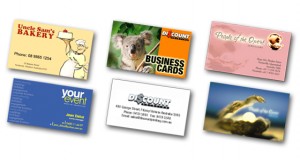Archive for Month: February 2010
The 11 Parts of a Business Card

Business cards are an essential tool for sharing contact information and brand building. Most business cards usually have standard information like the name of a person and the company name. Every business card is different and every company’s needs are different. Here are 11 essential and useful elements that a business card can have. Continue Reading…
Offset Printing vs. Digital Printing

In our modern business world, there are numerous options when it comes to printing. With new advancements in printing technologies, it can be difficult to understand what printing style is right for you and your business. Learn more about some of the advantages and disadvantages surrounding both digital printing and traditional offset printing.
What are bleeds, and do I need them?
The term bleed is used for all objects overlapping the border of your document. If your printed design contains graphics, images or colors that go right to the edge of the page, your design must include a bleed.
When you are creating your graphics for print you have to keep in mind that when your product is printed it has to be cropped and cut. If you do not include bleeds then your printed item may have sections of white border around the edges. The way to be sure to avoid this problem is to create your graphics and when you submit them include some extra room around the edges. When you submit your graphics the size should be larger than what the final document size will be. It is recommended that you leave 1/4 of an inch around the edge of your design for bleeds. Any colors that would be on the border of the image should extend to the edges so that when cropped, the edges will look clean.
Color FX has templates online that can be downloaded and show the bleed lines for products you are designing for print. Templates offered on the Color FX website can be downloaded in 3 formats: Adobe Illustrator EPS, Adobe Reader PDF or as a JPEG Image. Any questions you may have regarding bleeds can be answered in the Knowledge Base on offered on the website as well.
Preparing Print Material for Your Presentation
 When your company has a chance to make a presentation you are in a great position to build your brand, generate leads and convert new customers. A great way to make a memorable impression is to provide your attendees with material that helps develop your brand and strengthen your message. It is important to take time to figure out what printed material would serve as a useful informational tool, be something your attendees would enjoy receiving and maybe be something they could use in the future.
When your company has a chance to make a presentation you are in a great position to build your brand, generate leads and convert new customers. A great way to make a memorable impression is to provide your attendees with material that helps develop your brand and strengthen your message. It is important to take time to figure out what printed material would serve as a useful informational tool, be something your attendees would enjoy receiving and maybe be something they could use in the future.
As you begin your planning start by considering what will happen in the course of the presentation. Your attendees will arrive and quietly visit with others. Following that the presentation will begin and will most likely include an introduction, a thorough message, a strong closing and a time to address frequently asked questions. Finally, as the attendees are exiting they will inevitably visit with others and discuss the overall impression of the presentation. With the right print materials, the impression you leave your viewers with can be exciting, unforgettable and a great talking point.